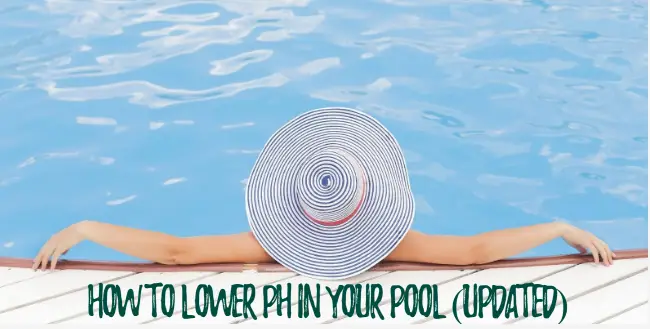How To Lower pH In Your Pool (Updated)

Having a pool is a great benefit to you and your loved ones. Virtually, summer is always around the corner which is the best time to have a dip for a better part of the day and sip beverages in the shade. Even thinking about it gives you a rush.
Having a pool aside, you need to keep it in a safe and pleasant condition to enjoy your time in it and keep your loved ones safe from health risks.
Water is a unique compound that has an excellent capacity to accept and absorb other chemicals. There are certain parameters that you need to keep in mind to keep tabs on the quality of water in your pool, such as its pH.
By definition, pH is the negative log of hydrogen ion concentration in a solution. It means the level of acidity and alkalinity in pool water when checked on a pH strip.
The key to keeping everyone healthy in your household is balancing all things in your pool, and by all things we mean the pH of your swimming pool!
As a general rule of thumb, the optimum range of pH for your pool water is from 7.4 to 7.8 on the pH strip. Due to weather conditions, the pH level can fluctuate on both the acidic side or alkaline side. When it fluctuates, it is not good news for both your loved ones and your budget.
Here is a list of the things that you may experience:
• Swimmers will complain about irritation in the eyes, dryness of the skin, and general stickiness in the body after every dip.
• The pool would appear cloudy or hazy which is not a friendly sight for someone who wants to have a swim in the pool.
• Chlorine is a common disinfectant that is widely used to kill germs and get rid of contaminants in the pool water. At high pH levels, chlorine is not efficient at killing germs. Keep in mind that it is more expensive to add more chlorine in the pool than testing the pH of your pool. Also, low chlorine levels in swimming pools make a great home for bacteria and algae.
• High alkalinity in your swimming pool causes hardness in water. This shows in the form of scales due to calcium deposit. This accumulation will clog the filters and pipes of your pool. This will result in the failure of pool equipment and instances of leakages.
How To Lower pH Levels
Keep in mind that you need to test the pH level of your swimming pool before treating it to achieve lower pH levels. For authentic testing, you can use pool test kits that are available in the market or you can buy them online. These can save you from a lot of trouble by giving you information on the health of your pool water.
Following are the things that you can gauge with this kit:
• pH level of your swimming pool water
• Acid Demand
• Total Alkalinity
Once, you have come to know that the pH level is too high for your swimming pool, it is time to get to work and restore the optimum level of pH in your swimming level.
There are two major compounds that are used to lower the pH level:
• Sodium Bisulfate (Dry Acid)
• Muriatic Acid
Now, we will discuss how you can use these chemicals:
Sodium Bisulfate
• Go through the container label to get the right amount based on the readings on your pool water. Professionals recommend that you should add the amount in multiple steps so that there will always be room for correction.
• Generally, Sodium Bisulfate comes in powder form. Take extra care when you are adding this to your pool water. For instance, steer clear from using it on a windy day to prevent blowbacks on your skin and clothes.
• If it is windy, you need to be downwind while adding this to your pool. Also, get down to the water as much as possible. Sprinkle it on the water return jet site to facilitate the spread of Sodium Bisulfate throughout the water.
• It will take around ten to fifteen minutes to dissolve the powder without any aid.
• At least, wait around six hours before retesting. It is ideal to retest within 24 hours after adding the powder.
Muriatic Acid
• This acid is a powerful corrosive that can be harmful to your skin. So, wear protective gear before handling this compound, such as safety goggles, gloves, etc.
• Follow the instructions on the manual or read the label on the container for a proper understanding of the usage.
• In general, you can add muriatic acid to your swimming pool in two ways: One of the methods is to introduce the acid in the lower end of the pool while the pump is turned off. You should go for a slow and steady stream of the acid to avoid splashing. Give the acid some time to settle at the bottom and then turn on the pump of the pool so that water is circulated throughout. The other method is to introduce it around the return jets and then turn on the pump. This will circulate it evenly in the pool.
Read more about Swimming
